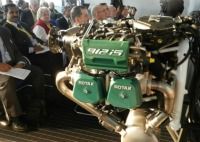
It could work out that out way, say Rotax engineers. At a press briefing on the company’s new 912 iS at Aero Friedrichshafen on Wednesday, Rotax officials told the assembled press that the new engine is flying in at least six of the dozen or so aircraft it had on display at its Gunskirchen, Austria rollout last month. The 912 iS features dual electronic fuel injection, electronic ignition and future knock sensing and protection. It’s equipped with two self-exciting permanent magnet alternators for redundancy and can deliver 100 HP on either avgas or up to E10 mogas.
The final version of the 912 iS software has been locked down and is awaiting only regulatory approval to begin shipping production-ready engines by May. During a question-and-answer session, Rotax engineers and Ben Ross, whose company, Rockwell Collins, makes the engine’s ECU, say that consistent electronic management of the engine, including better thermal control and smoothing out cycle variations may have positive implications on fatigue life of parts. Although Ross says it’s too soon to put numbers on this, he explains that the ECUs, with their sophisticated data logging and diagnostics, may be capable of collecting data to correlate reduced wear and longer service life of parts that could conceivably extend TBOs to as much as 3000 hours. The 912 iS comes out of the box with a 2000-hour TBO and given the large volume of 912/914 series already in the market — some 40,000 — Rotax has millions of hours of operational experience on its legacy engines. Given what appears to be wide acceptance of the 912 iS, Rotax may have meaningful operational data on that engine sooner rather than later.


































